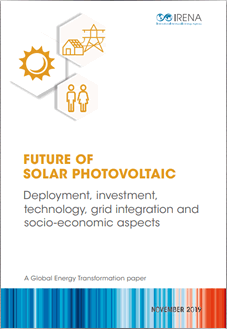Future of solar photovoltaic: Deployment, investment, technology, grid integration and socio-economic aspects
This paper from the International Renewable Energy Agency (IRENA) presents options to speed up deployment and fully unlock the world’s vast solar PV potential over the period until 2050.
Specifically, the paper highlights the growth needed in solar PV to achieve climate goals. It also offers insights on cost reduction, technology trends and the need to prepare electricity grids for rising shares of solar PV.
Among the findings:
- Accelerated solar PV deployment coupled with deep electrification could deliver 21% of the CO₂ emission reductions (nearly 4.9 gigatonnes annually) by 2050.
- Solar PV could cover a quarter of global electricity needs by mid-century, becoming the second largest generation source after wind.
- Global capacity must reach 18 times current levels, or more than 8 000 gigawatts by 2050.
- Asia would continue to dominate solar PV use, with over 50% of installed capacity, followed by North America (20%) and Europe (10%).
- Solar PV project costs, already below marginal fossil-fuel costs in global terms, are set to decline further in the decades ahead.
- Mobilising finance will be key, with IRENA’s roadmap estimates implying a 68% increase in average annual solar PV investment until 2050.
- Solar PV is a fast-evolving industry, with innovations along the entire value chain driving further, rapid cost reductions. Floating PV is a prime example, with global cumulative installed capacity exceeding one gigawatt in 2018 and clear potential for rapid growth.
- Rooftop solar PV systems have spread rapidly thanks to supporting policies, such as net metering and fiscal incentives.
- Energy transformation brings socio-economic benefits. The global solar industry could employ over 18 million people by 2050.
Details
- Source: International Renewable Energy Agency (IRENA)
- Source Link: http://www.irena.org
- Publication Date: 10/2019
- Country: United Arab Emirates
- Language: English
